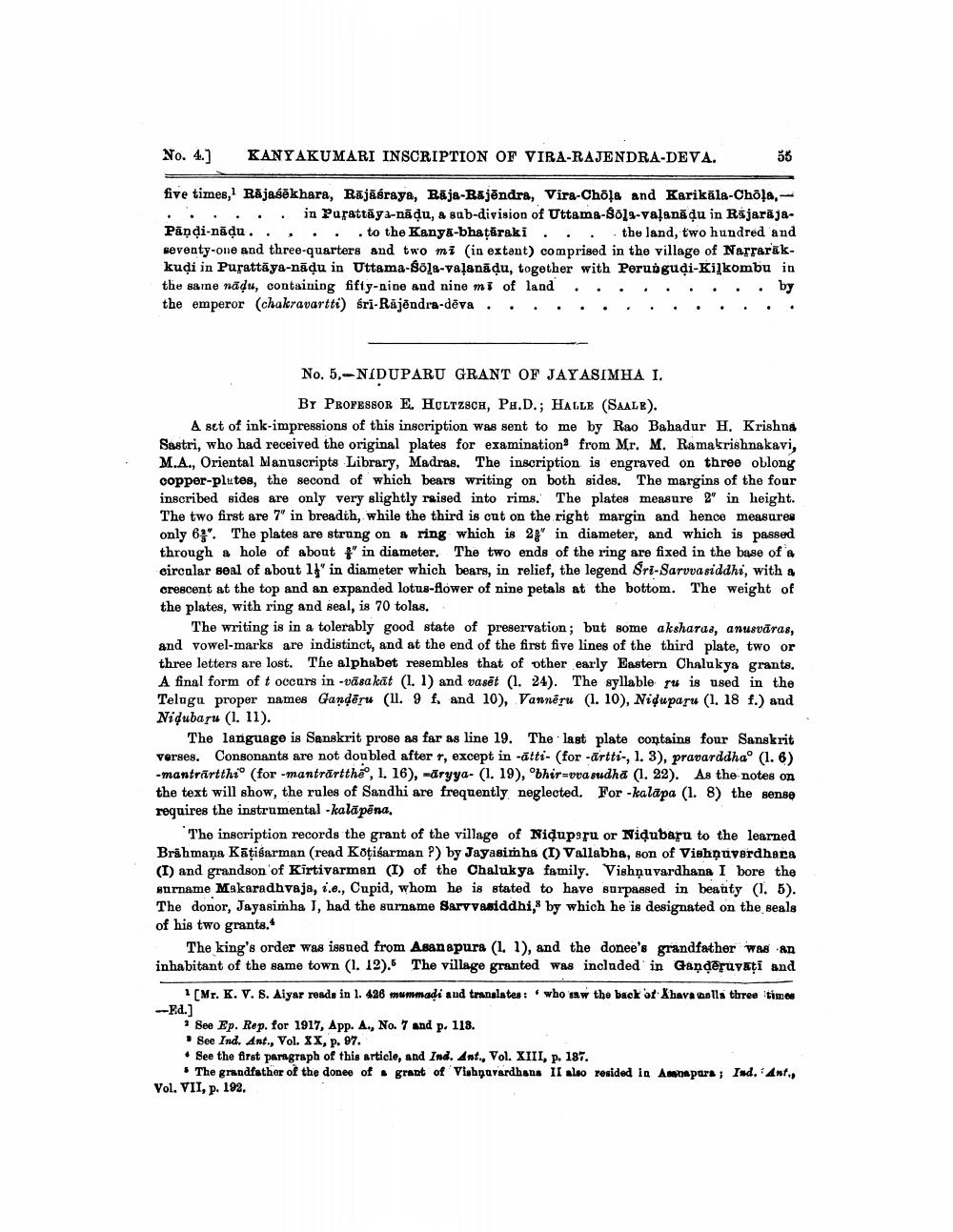________________
No. 4.)
KANYAKUMARI INSCRIPTION OF VIRA-RAJENDRA-DEVA.
five times, Rājasēkhara, Rajāśraya, Raja-Rajēndra, Vira-Chola and Karikāla-Chola, . . . . . . in Purattāya-nādu, a sub-division of Uttama-$29-valanādu in RájarājaPāņdi-nāļu. . . . . . to the Kanya-bhatāraki ... the land, two hundred and seventy-one and three-quarters and two mi (in extant) comprised in the village of Narrarākkuļi in Purattāya-nāļu in Uttama-sola-vaļanāļu, together with Perunguļi-Ki]kombu in the same nādu, containing fifty-nine and nine mi of land . . . . . . . . . by the emperor (chakravartti) fri-Rajendra-deva. . . .
No. 5.- NIDUPARU GRANT OF JAYASIMHA I.
BY PROFESSOR E. HOLTZSCH, PH.D.; HALLE (SAALE). A set of ink-impressions of this inscription was sent to me by Rao Bahadur H. Krishna Sastri, who had received the original plates for examination from Mr. M. Ramakrishnakavi, M.A., Oriental Manuscripts Library, Madras. The inscription is engraved on three oblong copper-plutes, the second of which bears writing on both sides. The margins of the four inscribed sides are only very slightly raised into rims. The plates measure 2' in height. The two first are 7" in breadth, while the third is cut on the right margin and hence measures only 63". The plates are strong on & ring which is 28" in diameter, and which is passed through a hole of about *" in diameter. The two ends of the ring are fixed in the base of a circular seal of about 1' in diameter which bears, in relief, the legend Sri-Sarvvasiddhi, with a crescent at the top and an expanded lotus-flower of nine petals at the bottom. The weight of the plates, with ring and seal, is 70 tolas.
The writing is in a tolerably good state of preservation; but some aksharaa, anusvāras, and vowel-marks are indistinct, and at the end of the first five lines of the third plate, two or three letters are lost. The alphabet resembles that of other early Eastern Chalukya grants. A final form of t occurs in -vāsa kāt (1. 1) and vasēt (1. 24). The syllable ru is used in the Telugu proper names Gandēru (11.9 f. and 10), Vannēru (1. 10), Niduparu (1. 18 f.) and Nidubaru (1. 11).
The language is Sanskrit prose as far as line 19. The last plate contains four Sanskrit verses. Consonants are not doubled after r, except in -ātti- (for -ūrtti-, 1. 3), pravarddha' (1.6) -mantrărtthio (for-mantrărtthe', 1. 16), dryya- (1. 19), obhir=rva sudha (1. 22). As the notes on the text will show, the rules of Sandhi are frequently, neglected. For -kalapa (1. 8) the sense requires the instrumental -kalāpēna.
The inscription records the grant of the village of Niduperu or Niềubaru to the learned Brāhmaņa Kātisarman (read Kotisarman ?) by Jayasinha (1) Vallabha, son of Vishộuvardhaca (I) and grandson of Kirtivarman (I) of the Chalukya family. Vishņuvardhana I bore the surname Makaradhvaja, 1.e., Cupid, whom he is stated to have surpassed in beanty (1. 5). The donor, Jayasimha I, had the surname Sarv vasiddhi, by which he is designated on the seals of his two grants."
The king's order was issued from Asan apura (1. 1), and the donee's grandfather was an inhabitant of the same town (1.12). The village granted was included in Ganderuvati and
[Mr. K. V. 8. Aiyar reads in 1. 426 mummadi and translates: who saw the back ot Xhava nella three times -Ed.]
* See Ep. Rep. for 1917, App. A., No. 7 and p. 118. • See Ind. Ant., Vol. XX, p. 97. • See the first paragraph of this article, and Ind. Ant., Vol. XIII, p. 187.
The grandfather of the doneo of grant of Vishnuvardhana II also resided in Ampapara; Ind. Ant., Vol. VII, p. 192.




